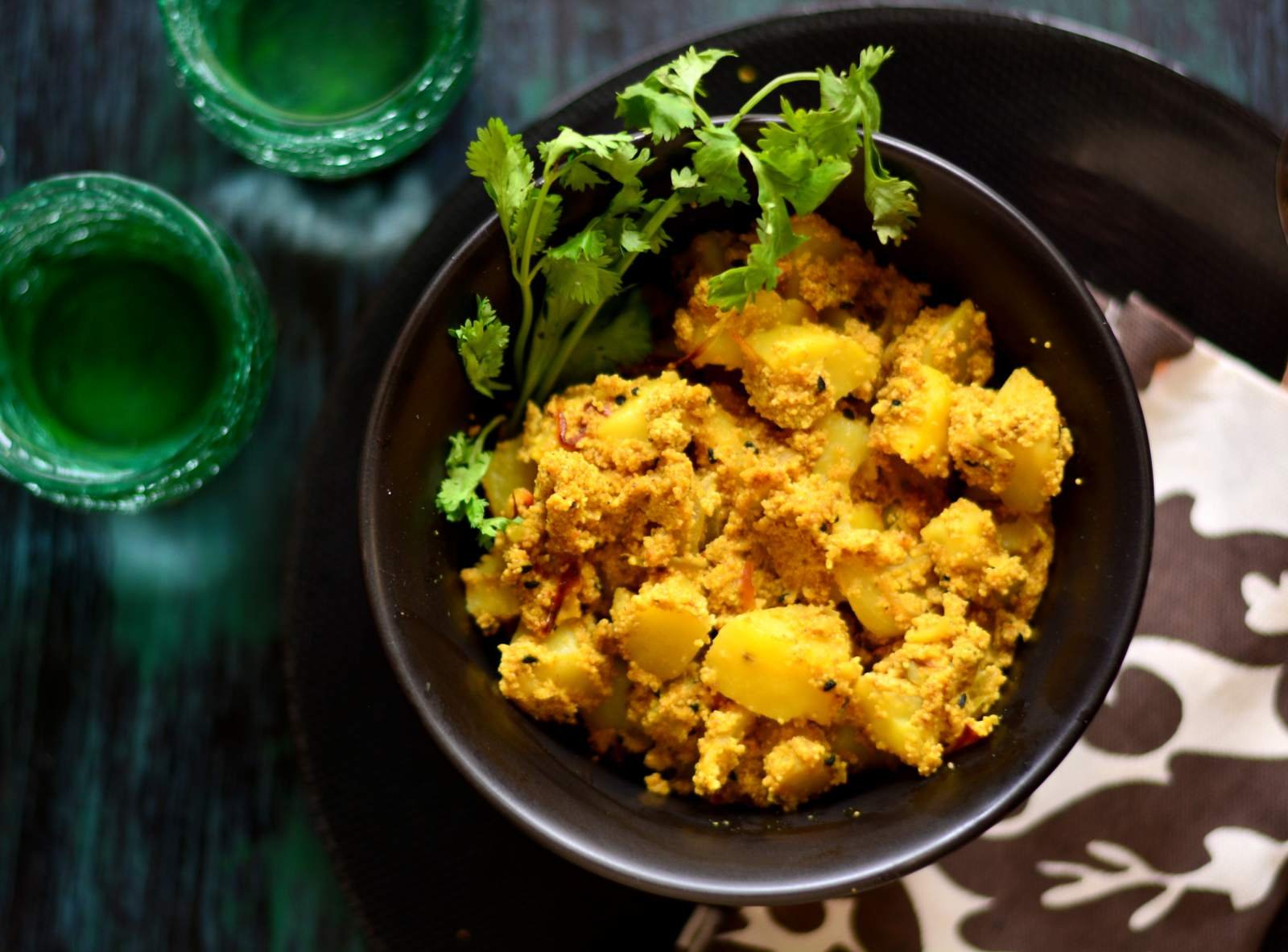Aloo Posto Recipe – A Simple Bengali Dish That Feels Like Home
Sometimes, the most comforting foods are the simplest ones. They don’t need a hundred spices or fancy techniques. They just need patience, love, and good ingredients. Aloo Posto—a classic Bengali dish made with potatoes and poppy seed paste—is exactly that kind of food.
If you’ve ever grown up in or near a Bengali household, chances are, Aloo Posto has been part of your life. For many Bengalis, it’s more than just lunch. It’s memory. It’s maa in the kitchen, the sound of mustard oil crackling in a pan, the smell of green chilies, and the sight of soft white rice waiting on a plate.
Whether you’ve eaten it before or are discovering it for the first time, this dish will win you over with its simplicity. Let’s make it together—not just as a recipe, but as a little journey into the heart of Bengali cuisine.
Ingredients – A Short List, But Mighty
Aloo Posto uses very few ingredients, which is why every one of them matters. The star is posto (white poppy seeds), soaked and ground into a creamy paste. The supporting actor? Potatoes. Soft, golden, and ready to soak up all the flavor.
Here’s what you’ll need (for 2–3 servings):
- 4 medium potatoes, peeled and cut into small cubes
- 4 tablespoons white poppy seeds (khuskhus/posto)
- 2–3 green chilies, slit or chopped (adjust to taste)
- 1 teaspoon kalonji (nigella seeds) – optional, but traditional
- 4 tablespoons mustard oil – essential for that pungent Bengali flavor
- Salt, to taste
- Warm water, for soaking and grinding the poppy seeds
Optional: A pinch of turmeric (some families use it, some don’t) and ½ teaspoon sugar for balance.
Preparation – Before You Start Cooking
Step 1: Soak the poppy seeds
Start by soaking the 4 tablespoons of white poppy seeds in warm water for at least 30 minutes. This softens them, making them easier to grind.
Pro tip: If you’re short on time, soak them in hot water for 10–15 minutes. But ideally, give them time to soak properly—it makes the paste smoother.
Step 2: Grind into a paste
Drain the soaked seeds and grind them into a fine paste using minimal water—just enough to get a thick, smooth consistency. You can use a traditional shil nora (stone grinder) or a small mixie jar.
Don’t add too much water or it’ll become runny. The paste should coat the back of a spoon.
Let’s Cook – Step-by-Step
Step 1: Heat the mustard oil
In a heavy-bottomed kadhai or frying pan, heat about 4 tablespoons of mustard oil. Let it get hot until it just starts to smoke lightly—that’s when it loses its raw bitterness and turns nutty and aromatic.
Reduce the heat to medium.
Mustard oil is crucial here. Without it, the dish lacks the signature Bengali punch.
Step 2: Temper with kalonji and chilies
Add 1 teaspoon of kalonji (nigella seeds) to the hot oil and immediately add slit green chilies. Let them sizzle for a few seconds until fragrant.
This step infuses the oil with flavor and gives Aloo Posto its classic aroma.
Adjust chilies according to how spicy you like it. Bengalis love the heat, but it’s totally up to you.
Step 3: Add the potatoes
Add the cubed potatoes to the oil. Stir well to coat them in the tempered oil.
Cook on medium heat for 6–8 minutes, stirring occasionally, until the potatoes begin to get a light golden edge.
Some people add a pinch of turmeric here for color, though the traditional version often keeps it pale. You can also add a pinch of salt now to help the potatoes cook faster.
Step 4: Add the poppy seed paste
Once the potatoes are half cooked, add the posto paste to the pan. Stir it gently to combine with the potatoes.
Add about ½ cup of warm water to loosen things up, cover the pan, and let everything simmer on low heat.
You’re not looking for a gravy dish here—just a moist, creamy coating that hugs each potato cube.
Step 5: Cook until the potatoes are done
Let it cook for 10–12 minutes, or until the potatoes are completely soft and cooked through. Stir occasionally and add a splash more water if it starts to dry out.
The dish should not be too dry or soupy—it should have a soft, almost creamy texture from the posto.
Step 6: Final touch
Taste and adjust the salt. If you want a tiny touch of sweetness, add ½ teaspoon of sugar at the end and stir once.
Turn off the heat and drizzle a few drops of raw mustard oil on top before serving for an extra kick.
How to Serve Aloo Posto – The Traditional Way
This dish isn’t meant to be eaten alone. It’s always served as part of a Bengali thala (plate).
The most traditional way is with:
- Steamed white rice (preferably Gobindobhog or any aromatic short grain)
- A spoon of ghee on the hot rice
- A side of Masoor dal (red lentil dal) or Kalai dal (urad dal)
- Maybe some fried eggplant or begun bhaja
Scoop a little rice, mix it with some dal and a bite of aloo posto, and enjoy. It’s soft, warm, nutty, and just a little spicy. The kind of meal that makes you close your eyes and smile.
Tips and Variations
- Texture matters: Make sure the posto paste is smooth—not gritty. That’s why soaking and grinding well is key.
- Don’t rush: Aloo Posto is slow food. It tastes better when gently cooked and allowed to absorb the flavors.
- No mustard oil? You can use another oil, but it won’t be the same. Mustard oil gives that signature pungency.
- Add onions: Some people (especially in non-vegetarian households) sauté sliced onions with the potatoes. It adds sweetness and depth but isn’t considered “niramish” (pure vegetarian).
- Add ridge gourd (jhinge): For a twist, add pieces of jhinge (tori) to the potatoes. It becomes Jhinge Aloo Posto—a lighter, summery version.
Why Aloo Posto Feels Like Home
Aloo Posto isn’t a flashy dish. There are no rich gravies, no heavy spices. But it teaches you something important: you don’t need complexity to create magic.
For Bengalis, Aloo Posto is about rhythm and routine. It’s about maa telling you to eat slowly. It’s about a light nap after lunch on a warm afternoon. It’s about comfort and calm.
It’s not a dish that tries to impress you. It’s a dish that holds your hand and sits with you, quietly, when you need it.
Final Thoughts
In a world of food trends and gourmet recipes, Aloo Posto remains timeless. It reminds us that a few good ingredients, when treated with care, can create something unforgettable.
So the next time you have a few potatoes, a little posto, and an afternoon to slow down—make this dish. Serve it with rice, eat with your fingers if you can, and let it take you somewhere softer, simpler, and beautiful.
Because sometimes, a humble bowl of Aloo Posto is all you need.

